9K33 Osa: BAZ-5937
 Soviet Union
Soviet Union
SPAAML (1960-88) based on BAZ-5937/39: 1,200 built, still active
An innovative truck-based SAM
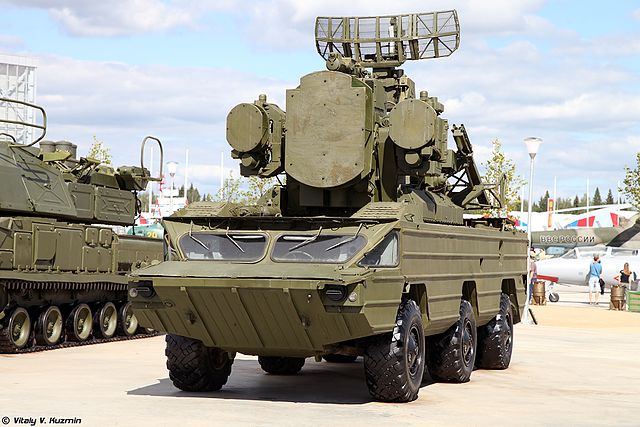
In service by 1971 but developed from 1960 onwards until 1972, the 9K33 complex "wasp" was the main low-altitude, short-range tactical surface-to-air missile system, organic to armoured divisions. 1200 were made on a modified BAZ-5937/39 chassis until 1988, with upgraded missiles. It was based on a 6x6 OSA-AKM amphibious truck (TELAR 9A33B, then TELAR 9A33BM2/3). It saw action in Lebanon (by Syria), Angola, Iraq, at the Russo-Georgian war of 2008, 2011 Lybian civ. war, Yemeni civ. war, in Nagorno-Karabakh, and Ukraine recently (15 lost). Poland and Belarus both developed their own variants.
Development
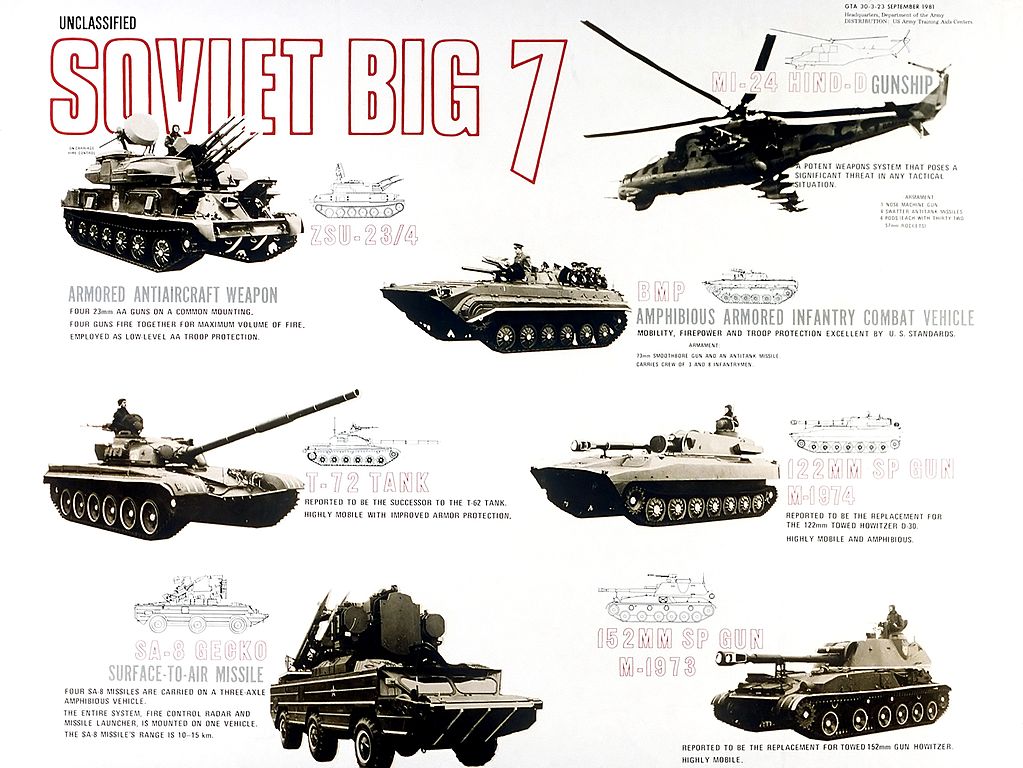
Soviet "big 7", NATO, threat
On July 27, 1960, in accordance with the Council of Ministers resolution, development of the air defense system started under the code name “Osa” but in the meantimle içn the official documentation it was project was called “Ellipsoid”. Work was difficult and with constant delays. By 1962, it had practically did not left R&D stage and experimental development under lead developer NII-20 GKRE. However soon M. M. Kosichkin was appointed as chief designer for the vehicle, and the Tushinsky Plant headed by A.V. Potopalov, was appointed for the development of the missile defense system. The launcher was developed by engineering design bureau GKAT.
The most difficult part of the work, was the creation of the missile defense system and in that, the Tushinsky Machine-Building Plant failed to meet developmental deadlines. Therefore, on September 7, 1964, by decree of the Central Committee, OKB-2 was appointed as developer for the missile defense system, P. D. Grushin being appointed as chief designer. At last a strick deadline was ordered for the the second quarter of 1970 for a testing prototype. In addition, V.P. Efremov was appointed as new chief designer for the "Osa" complex ("Wasp") with I.M. Drize was his army deputy. Delopment of a wheeled chassis was later passed on to the Bryansk Automobile Plant (BAZ).
By March to June 1970, the Osa complex was tested, and from July 1970 to February 1971, joint tests were carried out. Documentation was redacted and based on this, on October 4, 1971, by decree, it was adopted for service.
Design in detail

The BAZ TELAR 937-939 series
In 1969, BAZ developed prototypes of 6x6 military carrier trucks, the similar BAZ-937/938/939. During their development the GRAU index received the additional "5" so in production they became BAZ 5937, BAZ 5938 and BAZ 5939 respectively. These vehicles were unified with each other and all had in common a rear-mounted four-stroke diesel engine. The latter was a 5D20B-300 V6 (15,9 liter, 300 hp) diesel with direct injection. Transmission was a 5-speed manual gearbox, with two-speed transfer case and built-in symmetric locking differential. Suspension was independent of all wheels, using torsion bars. Top speed was 70 kph on flat unladen.
These chassis, used for a variety of weapons systems in the 1960-70s also had a built-in buoyancy due to their hull design, quite different than a standard truck. The large hull was indeed full of internal spaces and the vehicle could swim, being amphibious, and propelled by two water-jets, up to 8.0 kph. Fuel tank were also built-in inside, with a capacity of 320 liters on the left, forward of the rear axle. Fuel consumption was 40-42 liters per 100 km, so circa 730-780 km.
The first vehicles had shorter hulls, cropped front end, flat front panel but later ones got the caracteristic elongated sharp-nosed front, additional triangular cabin windows on both sides. The driver and co-driver or third member due to the large bunk, were all seated forward, seeing through two main windows, protected by folding-down lightly armored shutters. But there was no protection overall, even against small armed fire. That's whay they are considered as truck and not armoured fighting vehicles.
The BAZ-5937 weighted 7.5-tonne unladen (without the 9A33 complex mounted). The cabin was large enough for 5-6 and throughout its various versions, curb weight went, lade, from 10.7 to 11.4 tonnes. Basic dimensions were 9165 mm in lenght, 2782 mm in width and 1948 mm in height, without anything mounted.
The BAZ-5938 had a carrying capacity of 6.6 tonnes and was used as the support vehicle 9V210, with two crew compartments, three in all, and used for field maintenance/minor repairs organic to 9K33 units. It had a higher roof, completely enclosed body in which was placed the auxiliary/utility power unit, a gas-turbine to power all systems and equipment. Curb weight was 10.2 tonnes and fully loaded, 17.1 tonnes. Overall length was different at 9090 mm in lenght, 2840 in height. Range was improved at 775 km.
The BAZ-5939 differed in having a carrying capacity of 5.4 tonnes and was used generally as a missile loading/supply vehicle with a crew of three, organic to any 9K33 "Wasp" SAM unit. It differed by its open hull, sliding canopy cover the cargo compartment, additional gear with generator, modified brake system, backup power take-off and an hydraulic three-section telescopic crane to load missiles into the BAZ-5937 vehicle launcher. Its Curb weight was the largest of all three at 10.6 tonnes up to 16.3 tonnes fully laden, with spare missiles. It was also shorter than the others at 9040 mm in lenght for 1930 mm in height, same width.
All three chassis were composing a unit of the self-propelled air defense missile system 9K33 Osa, and under GRAU indexes, each unit was composed of the combat vehicle 9A33, loader vehicle 9T217 and the BAZ-5938 salvage and maintenance vehicle.
Missile
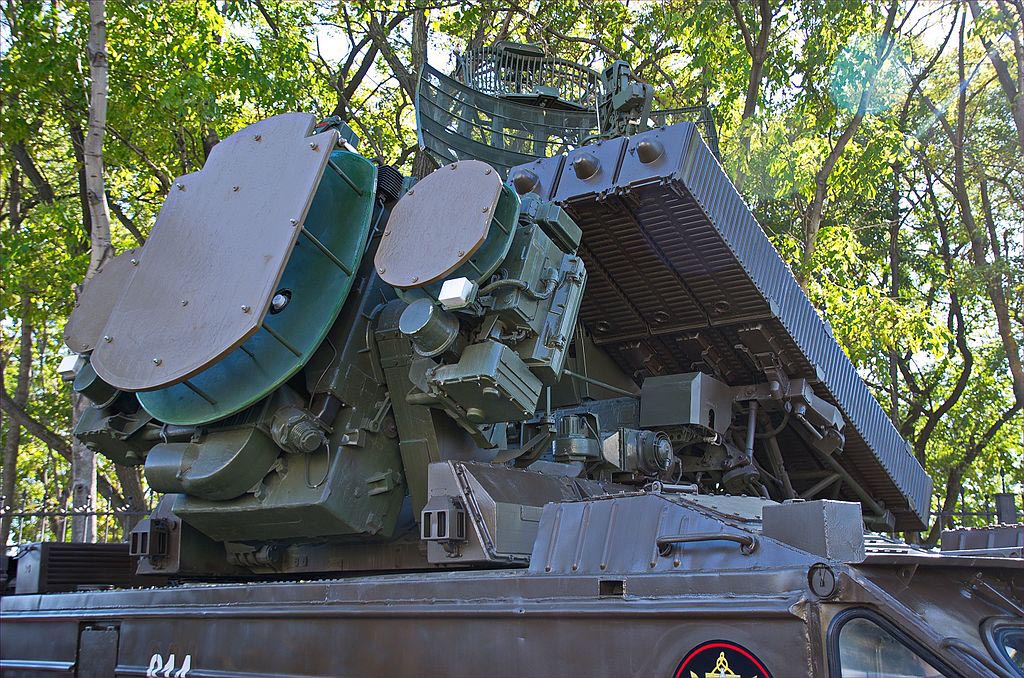
The missile was the centerpiece of the design, made for short engamenent distances initially only from 2 to 9 km (1.3–5.6 miles) at altitudes between 50 and 5,000 m (164–16,400 ft).
The 9M33M2 Osa-A was capable of 1.5–10 km (1–6.2 miles), altitudes 25–5,000 m (82–16,400 ft).
The 9M33M3 Osa-M was capable of 10–12,000 m (33–42,500 ft) and 15 km/9 miles could not engage targets at longer ranges (poor radar tracking). It was ideal to shoot down helicopters in all weather conditions.
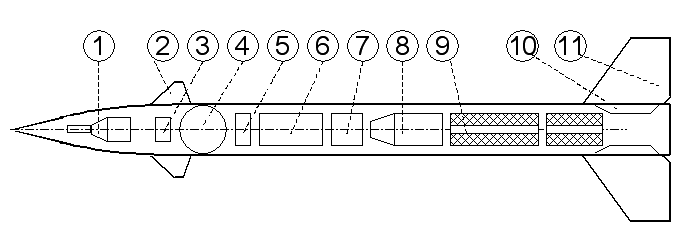
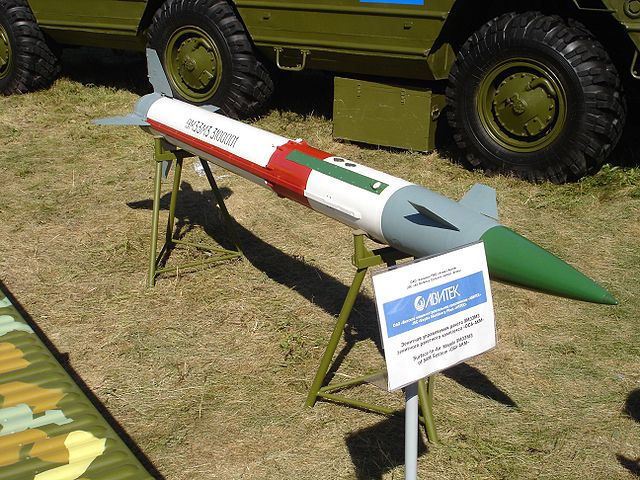 The 9K33, cutaway and M3 variant below on display
The 9K33, cutaway and M3 variant below on display
The 9M33 missiles measured 3.158 m (10.3 ft) in lenght for 126 kg (278 lb), command guidance and backup low-light optical tracking system, constantly improved under heavy electronic warfare environments. The 9M33M3 weights 170 kg (375 lb) for extended range and larger warhead. Propulsion for all depended of a dual-thrust, solid fuel rocket motor. Top speed is about Mach 2.4 and up to Mach 3 (at first Mach 1.4, Mach 1.6 for the M2\M3 on the start). The 19 kg (42 pounds) warhead went up to 40 kg (88 lb) for the M3 and is using proximity fuze-induced HE detonation. Some experts argues that further versions were tested with infrared and semi-active radar terminal homing seekers.
Each TELAR (carrier truck) is equippd with a massive, traversed turret type launcher, suporting both on its basis, the radar and launchers on two arms. The tracking guidance is able to direct two missiles simultaneously on any target with a 0.35–0.85 Kill probability, up to 0.55–0.85 for the Osa-AK/AKM.
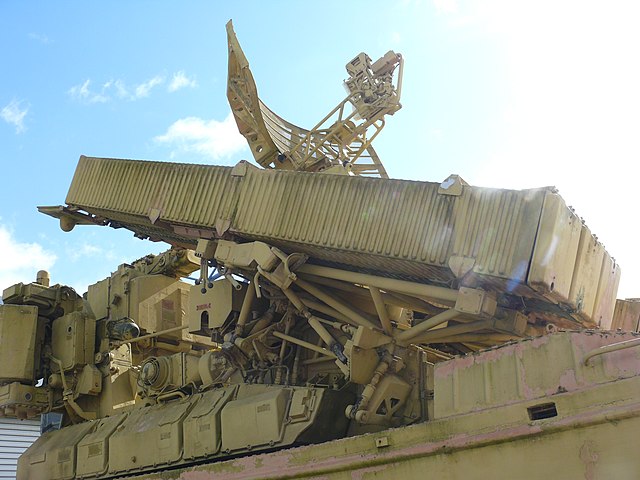
"When launched the booster motor burns for two seconds, this permits the radar to gather and control it at very short ranges (about 1.6 km). The sustainer motor has a 15-second burn, bringing the missile to a top speed of about Mach 2. Once launched the missile is command-guided for the whole flight, and the warhead is detonated by its proximity fuze or possible command. The warhead is said to have a lethal radius of 5 m at low altitude against an F-4 Phantom size target.[citation needed]
Radars


P-40 'Long Track' radar set
1S51M3 ("Land Roll") – C band target acquisition radar, H band conical scan target tracking radar and two J band pulse mode fire control radars (range 35 km/22 miles for acquisition, 30 km/19 miles for tracking and 25 km/16 miles for guidance). Mounted on the TELAR.
P-40 ("Long Track") – E band early warning radar (also used by the 2K11 Krug and 2K12 Kub, range 175 km/108 miles), mounted on a tracked vehicle (a modified AT-T).
P-15 ("Flat Face A") or P-19 ("Flat Face B") or P-15M(2) ("Squat Eye") – 380 kW C band target acquisition radar (also used by the S-125 Neva and 2K12 Kub, range 250 km/155 miles), mounted on a ZiL-131 truck.
PRV-9 or PRV-16 ("Thin Skin") – E band height finding radar (also used by the 2K11 Krug and 2K12 Kub, range 240 km/148 miles), mounted on a KrAZ-255B truck.
| Specs 9K33M3 |
| Dimensions : | 3158 x 209.6 mm |
| Weight | 170 kg |
| Warhead | Frag-HE, 16 kg, Contact and proximity |
| Propulsion | Solid propellant, dual-thrust rocket motor |
| Speed | 1020 m/s, 2 s boost, 15 s sustain |
| Guidance | RF CLOS |
| Range/ceiling | 15 km (9.3 mi)/12 km (39,000 ft) |
| Accuracy | 5 m |
| Platform | 9P35M2 |
Variants
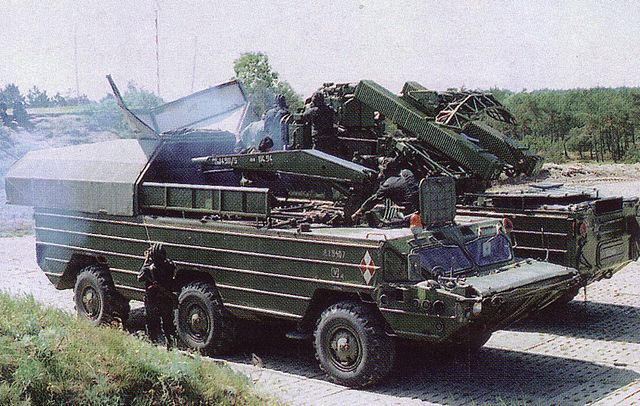 9K33 "Osa" (1971)
9K33 "Osa" (1971):(SA-8A "Gecko") Introduced 1971–1972, 4x 9M33, TELAR 9A33B, 12 km (7.5 mi) range
9K33M2 "Osa-AK" (1975): (SA-8B "Gecko Mod-0") TELAR 9A33BM2, 6-missile box launcher (9M33M2 in sealed round).
9K33M3 "Osa-AKM" (1980): (SA-8B "Gecko Mod-1") TELAR 9A33BM3, missiles 9M33M3 15 km (9.3 mi) alt 12 km (40,000 ft), IFF antenna
Operators
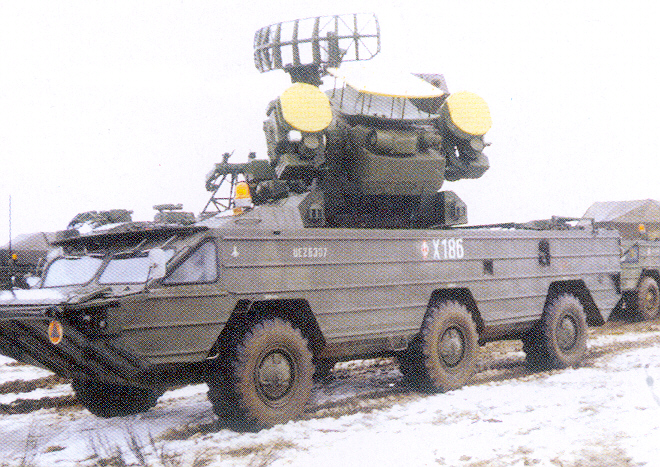 9K33M2 Osa AK in Polish service, 1980s
9K33M2 Osa AK in Polish service, 1980s
- Algeria: 28/48 vehicles
- Angola: 15 vehicles
- Armenia: c20 vehicles
- Azerbaijan: ?30, Upgraded to Osa-1T
- Belarus: Unknown, also upgraded
- Bulgaria: Unknown
- Cuba: Unknown
- Ecuador: Unknown
- Georgia: Unknown
- Greece: 39 systems in 6 batteries
- India: Unknown OSA-AK in service
- Iran: Unknown
- North Korea: Unknown
- Morocco: Unknown
- Romania: 16 launchers/8 reloaders, single regiment since 1989
- Russia: 400 Since 2007, Osa-AKM modernized, protection against spoofing
- Sahrawi Arab Democratic Republic: Unknown
- Sudan: Unknown
- Syria: 14 batteries, 60 vehicles
- Turkmenistan: 40 vehicles
- Ukraine: Osa-AK/Osa-AKM
- Artsakh vehicles seized by Azerbaijan after 2023 Nagorno-Karabakh war
- Czechoslovakia: 1 regiment, Czech Republic, discared 2006
- East Germany: 41 Osa-AK. Partially sold to Greece
- Iraq: 50 systems delivered between 1982 and 1985 plus captured Kuwaiti vehicles.
- Jordan: Retired 2017, 35 sold to Armenia
- Kuwait: Unknown, late 1980s, captured by Iraqi forces 1990
- Libya: 40 army + 50 Air Defense Command 1992, most destroyed 2011 Libyan civil war.
- Poland: 64, 32 upgraded to Osa-AKM-P1, retired 2017
Belarus variants
piccc
T38 Stilet
-9K33-1T "Osa-1T" by Belarussian "Tetraedr", with 9А33-1Т TELAR (BAZ-5937 or MZKT-69222) with new day/night camera OES-1T.
-9M33M2/M3 and 9M33M3-1 all had an improved missile range of 20 km
-9Т217-1T Transportation and Loading Vehicle (TLV)
-9V210-1T Maintenance Vehicle (MV)
-9V214-1T Alignment Vehicle (AV)
-9V242-1T Automatic Mobile Check-up and Testing Station (AKIPS)
-9F16M2 Ground Equipment Kit (GEK).
-T38 "Stilet": Modified Belarus Osa-1T with TELAR T381, MZKT-69222 chassis, missile T382, range 20 km.
Poland
Osa-AKM-P1 "Żądło" (SA-8P Sting) upgrade of the 9K33M2 "Osa-AK", 9K33M3 "Osa-AKM". 32 of 64 systems purchased upgraded on TELAR 9A33BM3-P1; First display at MSPO 2004 exhibition, Kielce, Poland, upgraded vehicle with passive detection/identification system SIC 12/TA and ISZ-01 IFF. In 2019 the Osa system environment upgraded, commissioned to WZU Grudziądz under €40-50 million.
| Specs TELAR 9A33B |
| Dimensions: | 9,165m x 2,782m x 1,948 m |
| Weight: | 7.5-tonne chassis light. With 9A33 complex curb weight 10.7-11.4 tonnes |
| Tires: | |
| Crew: | 5 |
| Propulsion: | 5D20B-300 V6 (15,9 liter, 300 hp) |
| Speed: | 70 kph, on water - 8.0 kph. |
| Range: | 738 km |
| Armament: | See notes |
| Production: | Circa 1,200 |
Combat Records
The Soviet Union started to deploy the 9K33 Osa organically in ots armoured divisions, rifle divisions (mot), guard divisions in the 1970s, and this seemed a promising system, with a reaction time from target detection to launch of 26 seconds. As of today, it is considered quite slow. Especially in case of a surging low-flying helicopter. More so, time to prepare the battery for a full engagements, between the road and setup, is around 4 minutes. Good in 1970, bad in 1990. The missile reloading needs a supply vehicle and takes around 5 minutes. Organization comprised in general one of several batteries at regimental and divisional level. Each battery comprised four TELARs usually accompanied by two reload vehicles with 18 missiles in sets of three. Each needed a crane for the operation. At divisional level, specialized variants could intervene. The Soviet versions never fought, but stayed in intense unit exercises up to the end of the cold war. Russian inherited a large park, for those not exported, gradually ported to the M3 standard (see later).
There were many export customers for these: Cuba obtained a few to defend its sensible sites, and more surprisingly Greece which had them at cheap, from former East Germany after the reunifications. The Warsaw pact also had it: East Germany (GDR) as said, but also Poland, and Czechoslovakia, as well as Bulgaria.
With tensions in the middle east, it was also exported notably to Syria and Iraq. After the Israeli invasion of Lebanon in 1982, Syrian air defense was rampaged by an air campaign which destroyed all known fixed SAM sites in the Beqaa valley. So the Syrians rapidly deployed Osas to reconstitute this defense area, and they managed to shoot down at least one confirmed F-4 Phantom on July 24, 1982 (Aharon Katz, Gil Fogel). The first died, the second was captive for two years.
In late 1980s, Cuba deployed these in southern Angola, causing significant concerns to the South African air force. The South African 61 Mechanised Battalion Group captured one of these, intact, on 3 October 1987 at the Battle of Cuito Cuanavale. Western intelligence agencies were quick to to examine it. The 1991 Gulf War saw the Iraqi also deploying these, but at that stage, the technology was more or less harmless to western aviation, using state of the art jammers and EW environment.
These vehicle also fought in the 2008 Russo-Georgian war, by both sides. Libya deployed these also during the 2011 Libyan Civil War, and they were still all destroyed by NATO airstrikes without shooting down any attacker. In the Yemeni Civil War by 29 November 2019, Russian sources claimed that Houthi forces shot down with one OSA, a Saudi Arabian AH-64 Apache. It was never confirmed and probably assimilated to the Houti's own version of the 2K12 Kub. More recently again, the system was deployed in the 2020 Nagorno-Karabakh conflict by Armenian Air Defense, notably in the opening days of the war in complement to 9K35 Strela-10 vehicles. They were destroyed by Bayraktar TB2 drones, with 12 9K33 Osa destroyed; but at least managed to shot down on 4 October 2020, an Azerbaijani Sukhoi Su-25 at Fuzuli. It was speculated the Armenian used a passive detection and shoot and scoot tactics to survive.
Last but no least the ongoing Russo-Ukrainian War following the 2022 Russian invasion so both Russia and Ukraine deplopying their own systems. On 30 March 2019 over Donbas already, the Ukrainian Joint Forces reported destruction of an insurgent Osa-AKM and Zhitel R330Zh jamming system. As of 20 September 2023, 15 Russian losses for this system as reported by OSINT, including 4 captured by the Ukrainians.
Sources
 trucksplanet.com
armedforces.co.uk
militarytoday.com/
weaponsystems.net
army-technology.com
wiki ru
worthpoint.com/ manual
recomonkey.com
trucksplanet.com/
BAZ-5937/BAZ-5939 de
9K33_Osa
baz-5937
commons.wikimedia.org
trucksplanet.com
armedforces.co.uk
militarytoday.com/
weaponsystems.net
army-technology.com
wiki ru
worthpoint.com/ manual
recomonkey.com
trucksplanet.com/
BAZ-5937/BAZ-5939 de
9K33_Osa
baz-5937
commons.wikimedia.org
Videos